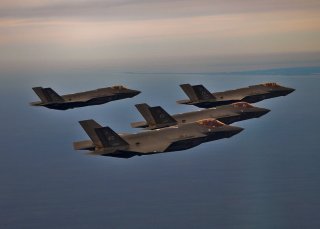Iran's Greatest Military Fear? Having to Fight Israel's 'Custom' F-35s
In another nod to the importance of Israel’s qualitative military edge in the region, the F-35I supports an indigenous Israeli electronic warfare (EW) suite.
Here's What You Need to Remember: An Israeli Colonel even speculated that Israeli tinkering with the American F-35 platform could even provide a benefit to the United States, saying the Adir is the “first-ever to be manufactured in the United States, per our request. Now, they will likely produce additional aircraft based on the current model for themselves,” though of course that remains speculative.
America’s F-35 is one of the world’s most capable and mature stealth fighter jets. Although the fighter has been widely exported to North Atlantic Treaty Organization (NATO) allies, Japan, and Australia, Israel is the only country that does not field one of the three standard F-35 variants. Instead, the Israel Defense Forces was able to wrangle higher-ups in the United States government and at Lockheed Martin to allow them to buy their own F-35 variant, the F-35I, which has some unique capabilities.
American-built, to Israeli Specifications
An Israeli Air Force press release explained the situation very succinctly, stating that “In the majority of the acquisitions made in cooperation with the United States, the IAF is given the opportunity to install its own electronic warfare, communications and weapons systems - all to accommodate the platforms to the relevant operational needs and requirements.”
Among the many not-inconsiderable of the F-35’s capabilities is its C4 architecture, which stands for command, control, communications, and computing. The F-35’s C4 allows pilots to glean valuable real-time battlefield information and share that information with other F-35s and troops on the ground. Israeli F-35s have their own, indigenous C4 architecture, which, being tailor-made to Israeli specifications, provides Israeli pilots with a smoother man-machine operation.
In another nod to the importance of Israel’s qualitative military edge in the region, the F-35I supports an indigenous Israeli electronic warfare (EW) suite. Additionally, the Spice kit, a highly-accurate guidance system that can be mated to a variety of Israeli weapons, gives weapons fitted with the kit a very high degree of accuracy.
Perhaps one of the more important aspects of the F-35I however, is its compatibility with Israeli built and designed weapon systems. An IDF Air Force Colonel explained it this way:
“New weapons affect the aircraft in different ways. We run an entire series of tests to certify a capability, such as load testing, fluttering, and release fluency,” he added. “In load testing, we examine the durability of the weapon and aircraft while performing complex maneuvers. In flutter testing, we check for aerodynamic phenomenon that may endanger the jet. While testing release fluency, we scan for issues in the release process of munitions - a significant test for the ‘Adir’ since its payload is released from an internal hold in the jet’s body. After the testing process is completed, we are able to determine the guidelines for operating with the new capability.”
The Israeli Air Force is going all-in on the F-35I, with two squadrons currently operational.
Postscript
The Israeli Air Force press release ended on a very optimistic note. An Israeli Colonel even speculated that Israeli tinkering with the American F-35 platform could even provide a benefit to the United States, saying the Adir is the “first-ever to be manufactured in the United States, per our request. Now, they will likely produce additional aircraft based on the current model for themselves,” though of course that remains speculative. “As soon as we’re fully prepared, we will be able to advance the ‘Adir’ Division and its capabilities.”
Caleb Larson is a defense writer for the National Interest. He holds a Master of Public Policy and covers U.S. and Russian security, European defense issues, and German politics and culture. This article first appeared last year.
Image: Flickr.

